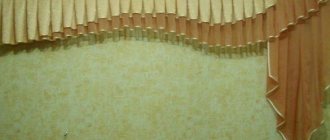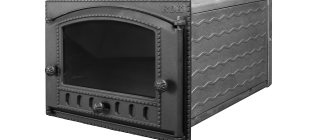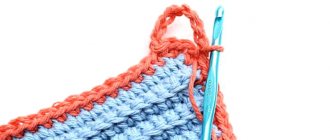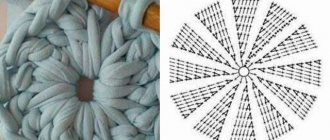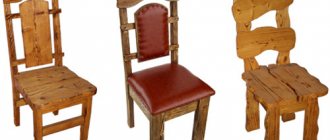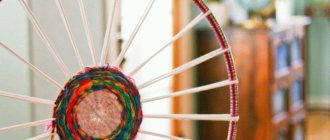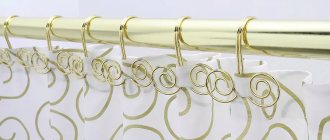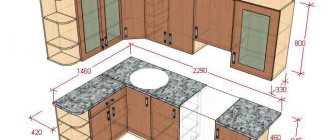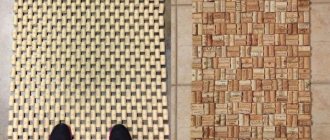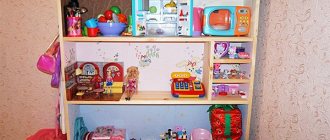To make such loops, prepare threads of the same color as the fabric (preferably iris), scissors and a number one hook.
We start knitting loops from the right corner, retreating 5 mm from the edge of the fabric. Having pierced the fabric with a crochet, you should knit it with a single crochet.
Now the column is the basis for knitting seven air loops from it - this will be the first loop. Having retreated 1 cm, we pierce the fabric again and knit new seven air loops, as in the photo. After this, we knit three air loops and again a column of seven single crochets.
You should end up with the following: a hanging loop and crocheted fabric. By alternating loops with knitting fabric, we achieve two goals:
- beauty of the product,
- strength and reliability of fastening.
Thus, according to the pattern “three air loops - seven single crochets” we knit the curtain to the end, and then the second one. To make the process easier to understand, you can watch the video.
Threads and tools
Threads are selected according to the type of fabric. Under light classic tulle (white, milky, beige), white cotton thread is best suited. If the curtain is made of a bright, multi-colored, iridescent fabric, then the color and material of the thread should be selected so that it does not attract attention, because the loops have an exclusively functional role, as decoration they are used only when the main function will be performed by them fully.
Review of sliding curtain rods - read on the portal LoveShtory.com
To sew loops on heavy fabrics, it is recommended to use knitting yarn. Cotton threads that are used in knitting summer clothes are suitable. Their strength is enough to serve for a long time.
Prepare a thin metal lace hook, fabric and scissors. When you get used to making threads and master the weaving process, you can try without a hook - the method of knitting rope for loops is not very complicated.
First way
Read the article about the mechanism for fastening Roman blinds at the link: https://loveshtory.com/vidy-shtor/podemnye-shtory/mehanizm-rimskih-shtor/
In the first case, you need a minimum of knitting skills; even beginners who have not held a hook in their hands can master it. In addition, if one hinge is damaged during operation, it can be replaced separately, without the need to change the others.
A prerequisite for this method is a careful calculation of the length of the loops and the distance between them. If the loops are different in length or at different distances, this will affect the appearance of the canvas: wrinkles will be visible where long loops are attached, and the waves of the curtain will be crooked and ugly.
The process of sewing on such loops is not quick, we hasten to warn you.
Second way
In the second case, the loops are a solid chain of knots, on which loops in the form of rings are periodically knitted.
Let's start with the most obvious drawback. If any loop is damaged, you will have to re-tie the entire chain. Simply fixing a particular section will not work - the chain begins to unravel when damaged. If you don’t re-link it, you will have to constantly adjust it in one place or another. This will make the curtains look untidy.
The advantage of this method is the relatively high speed of production and sewing compared to the first method. If the number of stitches was calculated correctly, if they are the same length, the curtain will look neat, and the chain itself can even be a unique way to decorate the top edge of the curtain.
Required tools and materials
To make this fastening method, you don’t even need a sewing raspberry - it’s enough to have basic sewing skills.
To make loops, in addition to the selected yarn, you will definitely need a crochet hook, already prepared material and scissors. You will need a lot of yarn, and the hook is selected depending on the thickness of the thread.
The thicker the thread, the larger the hook is needed, at the same time, if the thread is thin, you should not use a thick hook - it will be inconvenient to work with, and the finished loops will look unaesthetic and stretched.
Hanging up a towel
Towel loops are the easiest and fastest to make. First of all, because the product requires only one piece. However, on the other hand, if the weight of the curtain is distributed evenly on many hooks, then the towel is held on one, and in order for it to bear the load placed on it, it must be properly made.
So, how to make a loop of thread on a towel? The edge of the thread must be secured correctly, following the advice described above (inject the needle at a short distance from the edge) and having formed a strong loop from several arcs and stitching, complete the work, stepping back slightly from the edge of the arc. An important nuance in the case of towels will be the length of the loops. For curtains, it is selected depending on the cornice and the depth of the hooks. In the case of clothes, the loop is made slightly larger than the diameter of the button, but for towels it is better to lengthen it, for ease of hanging and removing from the hook.
How to make loops on curtains from threads and more
This enterprise is manual labor, so to create loops you will need: a needle, in some cases a hook, thread, scissors, a ruler (or centimeter), basic material and step-by-step instructions. Basic skills are also important, you need to be able to: make a knot, know common types of seams, be able to perform and make markings with special chalk (remnant).
For classic white tulle, it is better to choose a white thread.
Method of making threads with a needle
There is more than one way to make loops from threads with a needle. Each of them deserves attention, since usually the process of creation involves careful selection and production of even those elements that will not be visible.
If the fabric is multi-colored, iridescent, or has a pattern of a specific color on it, you should choose it based on how the finished product will look most natural.
Standard method - air loop
- Mark the beginning and end of the work with chalk.
- Determine the length of the chain.
- At the very beginning of the mark, you need to make a horizontal stitch, leaving a “tail of thread” of a couple of centimeters. Now make a few more stitches.
We determine the locations of future loops by dividing the distance into the required number of equal intervals.
We sew twice without tightening the loop.
We pick up the thread from the needle with our fingers through the loose thread.
Pass it through the thread and tighten it to form a loop of thread.
So we weave a rope of the required length (about 1 centimeter).
Insert the needle into the loop and tighten the thread.
All that remains is to sew on the second edge of the resulting loop and tie a knot.
If you get the hang of how to make loops for curtains from threads, you can make one such element in two minutes. The overall result of the work will be limited to half an hour of sewing.
The second method is an overcast loop
Part of the circuit is similar to a standard air loop, but there are nuances. After securing the first thread at the beginning of the mark, measure the required length and secure it on the second side. These two points will become the guidelines for creating shapes 0 or 8 using yarn. It doesn’t matter which one you choose, the result after the next stage will be the same.
How to knit
To make the thread stronger, it should all be knitted using the air loop method.
This knitting method helps strengthen the yarn.
In order to start knitting, you should secure it to the fabric with a simple knot, and then make one single crochet. Next, it is knitted with air loops and again attached to the material. The location of its strengthening depends on the chosen option. In the first option, a chain of air loops knitted to the required length is secured in the same place where it was attached from the very beginning.
After fastening, the remainder is cut off, so one loop is ready. After a certain period of fabric, after about 5-10 cm, exactly the same loop is knitted. This is done until the end of the material. The finished loops are put on the cornice.
When choosing option 2, you should attach the thread from air loops and not in the place where none was originally attached, but after a few cm. For fastening, use it in a single crochet. Thus, a wide loop is formed.
Next, the loops are made the same way across the entire width of the curtain. The cornice pipe is threaded into the finished loops. Having chosen the fastening option and the material for making the loops, you can begin making this method of attaching the curtain to the cornice. Date: 04/06/2015 Views: 807 Comments: Rating: 13 An important element of the interior of almost any room is curtains. A correctly selected accessory can emphasize style, add variety to the color scheme of the room, and become an original addition to the decor.
Fabric, color, tailoring - all this is done based on the personal preferences of the housewife. But the question always arises: how to make loops on the curtains so that they are convenient to hang/remove. There are several methods for making loops: air loops, drawstring, ribbon, bows, eyelets. Let's look at how all these loops are made below. There are many methods for attaching curtains, the main thing is to know the nuances of their manufacture and do the work competently and carefully. Air loops - this method of attaching curtains is useful if many small hooks are attached to the curtain rod.
How to process a buttonhole on a jacket by hand?
Welt loops are often found on jackets. Many sewing machines are equipped with a sewing function. But sometimes it is necessary to do this by hand if the thickness and density of the fabric does not allow it to be done by machine .
If you decide to perform the process manually, you need to do the following:
- mark and cut the loop;
- sew the sections with loop stitches, trying to make them the same;
- At the beginning and end of the loop, the stitches should be longer.
Important! When processing a loop, precision is needed; use a water-soluble marker for marking. The density and length of the stitches should be uniform. Do not tighten the thread. Practice on another piece of paper first. If you put a thread along the cut, the loops will gain relief.
Whatever type of hinge you choose, if they are made correctly, they will last a long time, be comfortable and delight others with their appearance. Perhaps your imagination will suggest new options for using thread loops and they will find a place in your creativity.
Decor
Bright and elaborate fasteners can sometimes become decorative elements themselves.
There are a lot of ideas for designing loops, let’s look at some of them.
- Form. You can attract attention with an unusual shape, for example, sew holders for a child's room window in the form of butterflies, flowers, animals or fairy-tale characters. To decorate with a marine theme - in the form of an anchor or seagulls. It is not necessary to make loops in the shape of rectangles - when cutting out, you can use any configuration.
- Color. Decorating with color will make the elements rich and attractive. If several types of textiles are used to decorate a window, it is not at all difficult to play up the tonality on the hinges. Sometimes the color of the fixtures supports some of the furnishings in the room, and therefore the entire style as a whole. For example, loops can follow fabric on bedspreads or sofa cushions. For the pop art style, you can choose the brightest colors. Fabric with a metallic sheen will suit loft or techno styles. Gothic will need dark, solid fabrics, and for romantics, something pink, lilac, soft lilac, blue or pistachio will do.
- Texture. It must also match the surrounding environment. For example, to support the colonial style, fastenings are decorated with stripes with folk patterns or fur, combining it with a carpet in the form of an animal skin. For the kitchen, the texture of the fasteners is selected from simple, understandable materials: cotton, linen, satin, fine wool.
- Decorations. Ruffles, bows, lace decorating curtain holders indicate a romantic style, Provence, vintage, country, shabby chic. Rhinestones, shells, stones, glass beads, embroideries, and appliques are used to decorate loops.
Material – fabric
Such fastenings come in several types: with ties, with Velcro, with buttons or with decorative loops.
- To make fabric loops, which can be either blind, that is, stitched on both sides to the curtain, or swinging, you will need:
- scissors,
- fabric of the same color as the curtains, or contrasting,
- sewing machine,
- threads in the color of the fabric for the loops.
- To begin with, strips of the required width are cut out of the fabric. In our case, the width of the finished loops should be 5 cm. Therefore, the pattern should be made 11 cm wide, since this part will be folded in half, plus 1 cm of indentation. Part length – 20 cm.
- You need to cut out as many such strips as will fit on the curtain fabric, taking into account that the loops will be located at a distance of 10 cm from each other.
- Then carefully grab the edges of the patterns with a needle. This is necessary to improve the aesthetics of the product, as can be seen in the photo.
- After this, the loops can be sewn on a sewing machine.
- The last step in making fabric loops is to sew them directly to the curtain.
Conclusion
Curtains made of any material need fastening that will favorably emphasize the advantages of the fabric and highlight features: sophistication, sophistication or playfulness, as well as rigor and restraint.
As a result, you will receive reliable fasteners for curtains that will last a long time and will not spoil their appearance.
Self-made curtain loops can contribute to this in the best possible way, since the craftswoman herself chooses what to emphasize and what not to highlight. Only for this it is necessary to calculate all the nuances, plan correctly and implement it into reality without defects and errors, so that the result brings pleasure for as long as possible.
How to sew curtains with hinges with your own hands
Before you begin the process itself, you need to prepare everything you need.
In order to sew curtains with hinges with your own hands, you will need:
- Fabric for curtains;
- Sewing machine;
- Threads;
- Additional materials, patterns, accessories.
Before you start sewing curtains with hinges with your own hands, you need to accurately measure the dimensions, the width of the curtains according to the window openings and the length of the curtains. To do this, you need to take into account the width of the window, add gaps on the left and right sides if the curtain is solid, or gaps on both sides on both panels if the curtain consists of two panels. If the curtains are planned to have waves, you need to calculate their number according to the width of the window and add the depth of each wave to the resulting width. The width of the future curtain is ready, the length of the product is determined by the window or the floor, taking into account the loops.
Armed with imagination and the necessary materials, you can begin making curtain loops
Next, you need to decide on the loops, or rather on the material from which they will be made: fabric, braid or thread.
Then you need to calculate the number of loops that will hold the curtain on the curtain rod and first place them on the curtain, marking these places with soap or a pencil. Then we start sewing the loops. Fabric loops are the most common model. To do this, you will need braid and strips of fabric of a width that harmoniously matches the curtain, its color, pattern, etc. A strip of fabric is folded inward on both sides, a braid is applied to the middle and stitched in the middle along the entire length of the strip. The resulting piece of fabric is connected at the ends to the bottom and applied to the curtain, placing the curtain on top of the resulting loop. The curtain is stitched, capturing the loop. Such loops are the most convenient to use; they hold the curtain well, fit comfortably on curtain rods and baguettes, and wash well.
The main stage is sewing curtains ↑
Methods for making hinges - blind and detachable ↑
To sew one-piece rectangular loops, follow the algorithm:
- Fold the fabric flaps in half with the right side inward, step back 1.5 cm from the edge and sew the seams, leaving the narrower side unstitched.
- Turn the product right side out and iron it carefully.
- Fold the edges of the unsewn side of the loop inward and connect them with a stitch; if desired, trim the edges of the pata with a contour seam.
How to process a buttonhole on a jacket by hand?
Welt loops are often found on jackets. Many sewing machines are equipped with a sewing function. But sometimes it is necessary to do this by hand if the thickness and density of the fabric does not allow it to be done by machine .
If you decide to perform the process manually, you need to do the following:
- mark and cut the loop;
- sew the sections with loop stitches, trying to make them the same;
- At the beginning and end of the loop, the stitches should be longer.
Important! When processing a loop, precision is needed; use a water-soluble marker for marking. The density and length of the stitches should be uniform. Do not tighten the thread. Practice on another piece of paper first. If you put a thread along the cut, the loops will gain relief.
Whatever type of hinge you choose, if they are made correctly, they will last a long time, be comfortable and delight others with their appearance. Perhaps your imagination will suggest new options for using thread loops and they will find a place in your creativity.
Making loops with a needle
Loop size chart.
You need to place a thread folded in half into the needle. Mark the top edge of the curtain using dry soap or tailor's chalk. The future locations of the loops must be determined in advance. The more loops you make, the smaller the curtain folds will be. In this case, the canvas will lie smoother, there will be more folds, as well as loops. The loops should be made 1-2 cm below the edge. Hooks and loops should be on the wrong side and should not be visible.
Insert the needle into the fabric so that it does not come out on the right side or comes out minimally. Sew a few small stitches to secure the base. Pull about 1 cm of thread through a loop and secure it again. Sew this blank. To do this, pull the needle and thread into the loop, you will get another loop, pull the thread into it and tighten. Repeat this several times to get a strong loop base that is completely wrapped with thread. You need to strive to ensure that the stitches are located as tightly as possible.
It should not bend or lose shape.
Related article: Basic architectural elements of the facade, names and ways to emphasize them with lighting
When the first loop is completed, you need to secure the thread and cut it. The following threads must be made in accordance with the markings made in advance. As a result of the work done, you should receive a number of even, identical in shape and size loops along the top edge of the curtain. Use a wide eye needle.
Choosing material for curtains
Curtains with hinges are most often used as the main elements of window decoration. For their manufacture, dense curtain materials are used. Patas are made from the same material or use companion fabric. Curtain loops can be several shades lighter or darker than the curtain or have a color that is in harmony with other interior items. To prevent the curtains from stretching out under the weight of the curtain, a material that is no less dense than the curtain material is used for sewing.
Curtains or curtains made of light fabric are hung on cornices equipped with small hooks that move freely inside a metal rail. To do this, small thread loops for curtains are sewn to the canvas. Any housewife knows how to make eyelets on a curtain by hand using a hook or needle with strong, harsh thread. This method of hanging is used for light silk, cotton or tulle curtains.
Description of loop execution
For strong fastening, the air loop method is suitable.
First, the yarn is secured to the fabric with a regular knot. Next, using a hook, we knit a regular single crochet. Having tied a chain of the required length, the second end is secured to the fabric. Once secured, cut off the free end of the thread. This will be one loop from the first method.
In the second method, you first knit a single crochet along the length required for one loop. Then the last loop is fastened to the first. The resulting ring is one loop. Next, we knit a single crochet for the distance required for the gap between the two loops. Next is a single crochet for a new loop. We fasten it into a ring of the same size as the first loop. And we repeat this until we knit a chain of the required length.
After finishing knitting, sew the chain to the upper edge of the curtain using hidden stitches.
Calculations of loops on curtains
In specialized literature you can often find a variety of advice on sewing curtains with eyelets with your own hands. But not all of them are worth believing. Detailed instructions should contain dimensions, as well as instructions for accurately performing all actions. Beginners who have not previously dealt with such a task should use a special tape for curtains with loops.
You should start working with calculations, which will become the basis for the patterns. But before that, you should choose the type of fastenings: blind or unfastening. The required amount of material will depend on this choice. You should also decide whether there will be folds on the future curtain; the amount of material used also depends on this. The length of the canvas is determined by the formula: the width of the window opening is multiplied by the assembly factor (fold depth). To the resulting figure you should add another 10 cm for the edges.
Next, the number of loops is calculated. Too large gaps between them make the canvas saggy, it looks unsightly on the cornice, so the distance between the fasteners must be selected in accordance with the length of the cornice. The standard height of the loops is 10-15 cm. Based on these data, the optimal number of loops is determined. It is important to leave 3 cm at the edges of the canvas, this is necessary for processing the edges.
General recommendations
The process of creating curtain or tulle fastenings in itself is not difficult to perform; you just need to gain some skill. But there are also nuances that come only with experience - calculation. This is determining the length of the curtain, the distance of the bottom cut from the floor, the need to process the edges and methods, sequence. It should be taken into account that if there is an additional folded seam at the top, the length of the product will be shortened and may look untidy with too much margin.
If you want more folds and then make a beautiful drapery, then the distance between the loops can be slightly increased.
A more even canvas on the window opening is made by sewing a large number of identical loops. It is difficult to give specific numbers; one must still take into account the total length of the material, its heaviness and tendency to form folds.
Sometimes, if the fabric is thin but difficult to drape, you can increase the distance to 20 cm to “force” it to take the desired shape.
If we talk about the length of the loops themselves, how to choose them, then here it is worth starting from: the length of the material and the highest point of grip of the loops. In other words, the length should be selected individually, taking into account whether there are restrictions on distance from the floor; if you need to raise it, then the loops are shorter, but in order for the curtains to be visually longer, the loops will be calculated differently.
If the loops are not intended for decoration, then they try to place them in inconspicuous places.
Important: the distance by which the fabric needs to be raised or lowered is not equal to the length that the housewife will add or shorten, so it is better to play it safe and “try on” the product for its future location before sewing.
Fastening with bows
The required number of strips measuring 8x51 cm are cut. Each strip is folded in half lengthwise from the front side inward. A stitch seam is laid along the length, but the ends are left open.
It is better to smooth out the seams, after which the strips are folded so that the seam is in the middle. Each strip has a stitch along either end. The corners of the allowances are trimmed at the seams, the strips are turned outward.
The open ends of the strips are sewn up, and all blanks for bows are steamed. After hanging the curtain, a bow is tied near each loop. Such stripes can be made from fabric of a lighter or darker shade, then bows can be the main accent on the curtains.
The strips can be made of another material, which will make the entire composition heavier or lighter.
Each housewife can choose how to sew curtains with hinges with her own hands - her own version is always more interesting. Such curtains can be hung not only on windows, but also instead of interior doors; this option can delimit the internal space of rooms. This is the most popular way to decorate not only the living room, but also the bedroom and even the kitchen. Such curtains can be made from any material, thus creating a unique atmosphere in the house. Only imagination and diligence will help you create real handicraft masterpieces.
Cutting and sewing loops
Interior design consists of little things, each detail makes the room unique. The combination of textiles with the furniture composition as a whole is especially important.
First, we prepare the fabric and its cut; to do this, you need to take a fabric of the required size, which should first be ironed so that the measurement and pattern are more accurate. Measuring the fabric, divide it in half for two even curtains, and carefully cut it. After the allowances are measured, they are hemmed only on those sides where the edges of the fabric are not finished.
There should be 2 such allowances; they will serve as a strong hem so that the fabric does not crumble or fray. About 2 cm is set aside from the edge and markings are made, then they are connected with a solid line, after which another 3 cm is set aside and a line is made with markings. Thus, from the edge there will be 2 markings, along which the curtains are folded and hemmed. This double method will not allow the fabric to tear over time.
Next, a loop is made. You need a lot of them, and they can be blind (i.e. one-piece), with fasteners, buttons or ties. For blind loops, small rectangles of fabric are cut out, the number of which depends on the style of the curtains, the main thing is that the distance between them is the same.
Each rectangle is folded inward, right side in half, and stitched to fit together. All the rectangles are stitched together in this way, after which they are turned inside out and steamed to make them even and flat. Afterwards the remaining edges are processed and joined together.
Where to hang a towel?
Here are the most popular and practical places for a towel in the kitchen:
- Sink apron.
- Horizontal plate handle.
- The inside of cabinet doors.
- Refrigerator door from the outside.
- Special retractable kitchen modules.
To fix it in a hanging position use:
- Self-tapping hooks. They are suitable for walls covered with wallpaper or cabinet doors that you don’t mind getting damaged. Self-tapping screws securely fix the hook, which, in turn, can withstand even thick and heavy towels.
- Hooks with vacuum suction cups. These devices can be used on tiles and other smooth surfaces, including cabinet fronts and glass panels.
- Self-adhesive hooks. The adhesive side of the hook holds securely on both smooth and rough surfaces. Such devices are also easy to remove, without leaving a sticky residue.
- Magnetic hooks. A fresh and unconventional idea for storing products. The hooks are attached magnetically to the side walls of the refrigerator or other metal surfaces.
- Railing. A very convenient thing that allows you to hang not one, but several items. On the railing, the towel can hang straightened, which means it will dry faster. A towel on a railing looks much more aesthetically pleasing than on a hook, the only drawback is that it takes up space on the work surface. If you don’t want to make a lot of holes in the tiles for towels, then you can drill just two holes and attach a longer rail to hang dish organizers, towels and detergent dispensers on it.
Kitchen options
There are many ways to diversify the product, for example, such as sewing two curtain panels together, combining different colors from the same fabric, or decorating the bottom of the curtain with ruffles, lace, decorative fabric, or decorating the curtain itself with decorations.
Roman curtains are a good option for the kitchen - they are calm, easily harmonize with any interior, and are varied.
But there are additional recommendations that will be useful to anyone who is planning to sew curtains with hinges for the kitchen on their own:
- Not everyone is ready for bold decisions in the interior, but if you want something extravagant, you can make bright contrasting hinges. It's fashionable now.
- Patas with buttons look interesting and attractive. This gives the room a special sophistication. Such a curtain will look especially bright in a children's room. Buttons will look more interesting if you choose multi-colored ones.
- To avoid sagging of the curtain, it is better to make the space between the patches 2-3 times wider than the width of the patch itself. This is especially true for curtains made of heavy material.
- You need to make enough loops to cover the width of the entire curtain. It is better to stock up on excess material than to face the problem of not having enough loops.
- To make the curtain look flowing, you need to take fabric 2-2.5 times wider than the length of the curtain rod. And it is better to choose a light transparent fabric for this effect.
- If the print on the product is vertical and the product itself is long enough, it will create the appearance of a high ceiling, which will visually enlarge the entire room. At the same time, if the drawing is horizontal, as a result the room will become visually wider.
That's all you need to know before you get started. The main thing is to properly harmonize the patterns with the product itself, to make them long and wide enough so that it not only looks beautiful, but is also practical. Otherwise the work is easy and quick. And it is possible for all owners who want to create comfort at home with their own hands.
Preparing items for sewing
Before you start cutting and sewing, you need to prepare everything you need to create curtains with hinges. This:
- Fabric for the product itself and for the patches;
- Tailor's meter or tape;
- Adhesive backing tape;
- Threads;
- Needles;
- Scissors.
- Save
You should also first place the cornice above the window. Remember that it should be located no lower than 10 centimeters from the top border of the window opening to avoid a strip of light between the curtain and the cornice. It is also necessary to take measurements of the width of the curtain or curtains, to determine whether the curtain will be pleated or smooth.
Calculation of canvas size
- Save
Depending on how the curtain will be placed on the cornice - hang in the center or symmetrically on the sides, cover the entire wall or part of it - we calculate the size of the canvas. For smooth curtains, it is enough to measure the expected width and add seam allowances of 1.5 centimeters on each side.
For pleated curtains, in order to make the flounces spectacular, experienced craftsmen suggest calculating the width twice as large as what would be needed for a smooth curtain. For pleated curtains, the loops are not attached directly to the material, but to a special edging that is sewn or glued on the reverse side.
Similarly, we calculate the height of the curtain based on the height of the cornice. If you are going to sew a Roman curtain, be sure to add fabric to the horizontal folds.
Determining the size and number of loops
- Save
- Save
The next step is marking the loops. Decide on the quantity, try not to place them far from each other to avoid sagging. For thick curtains, the optimal loop width is about 6–8 centimeters, and for thin tulles, which weigh much less, narrower loops are also suitable.
Example: for a single curtain that will hang directly above the window, in an opening of a standard size of 140 centimeters, 6 loops each 6 centimeters wide, which will be located at a distance of about 20 centimeters from each other, will be sufficient
But you can make the number of loops even greater, focusing on them as an interesting decorative element
Cutting out curtain parts
After final preparation and taking measurements of the future curtain, you can proceed directly to cutting. It is recommended to make a pattern template for the main fabric and a standard loop, especially if you are doing this kind of work for the first time or plan to sew several curtains at once.
- Save
Place the pattern on the fabric, measure the allowances on each side, and mark them. Cut out the fabric, trying to keep the warp threads parallel and perpendicular to the edges.
To cut the loops, measure exactly twice as much fabric in width (each loop will be double-sided). Insert stripes taking into account allowances.
Separately, you need to cut a strip of fabric for the facing - it will be approximately 10 centimeters wide and the same length as the width of your future curtain. For the facing strip, cut out a strip of 8 centimeters wide from the adhesive backing and the same length as the facing.
